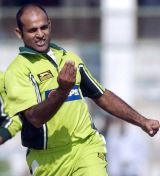The last three weeks have been particularly forgettable ones for the Australian one-day team, and while the performances all round have lacked polish, the one aspect that opposition teams - mostly New Zealand - have exposed and mercilessly exploited has been the bowling at the death. In the second ODI of the series
at Auckland, the Australians were smashed for 106 runs in the last ten overs; in the
next one they went for 77; and a little before that, in the CB Series at home, they were clobbered to the tune of 89 and 86 in the final ten overs in their last two league matches against England and New Zealand. These are highly unusual numbers for a team which prides itself on discipline, accuracy, and strangling the opposition. Aravinda de Silva, the former Sri Lankan batsman, commented recently that "the rest of the bowling [apart from Brett Lee] looks very average. Even scores of 275 or 280 can be chased against the Aussies." Chances are that over the next few days leading to the World Cup, more cricketers - both past and present, and not belonging to Australia - will voice similar opinions.
Australia's slump in bowling form - especially in the final part of the innings - is apparent from the table below. In the last one year, the only team which has gone for more in the last ten overs is New Zealand, and even there the difference is marginal. Going by the numbers in the last year, the hosts will have the advantage in the last ten - not only do they concede less than a run a ball on average, they also pick up wickets at regular intervals.
The next two tables provide further illustration of Australia's bowling woes - none of them figure among the top ten most economical bowlers at the crunch. Muttiah Muralitharan and Harbhajan Singh have the same economy rate, but Murali's wicket-taking ability - he averages 23 to Harbhajan's 60 - makes him far more lethal.
Some of the other names in the list are interesting too. Marlon Samuels and Chris Gayle prove the effectiveness of firing the offies flat and fast in the last few overs, while their presence also explains West Indies' position as the best team at the death. In fact, the preponderance of slow bowlers also suggests that's the route more teams might opt for during the World Cup. Andrew Hall emerges as South Africa's best bet, but the entry that might perhaps surprise many is slotted three places below Hall. Rana Naved-ul-Hasan has struggled mightily for line, length, swing and control over the
last one year, but with old ball in hand when the slog is on Naved is a transformed bowler - his average and his strike rate are, quite incredibly, less than ten. Compare those numbers with his stats in the first 40 overs of an innings - an average of 58.69, an economy rate of 5.36, and a wicket every 66 balls - and you know exactly how Pakistan should use him in an ODI.
And if you're wondering where all the Australian bowlers have vanished, have a look at the next table, which lists the most expensive bowlers during the slog. Stuart Clark is the second-most profligate bowler, conceding almost eight runs per over, while Nathan Bracken and Brett Lee both leak more than seven. Glenn McGrath doesn't quite make it into the list of most expensive bowlers, but his economy rate of 6.68, coupled with an average of 27.71 suggests he hasn't been the most effective slog-overs bowlers either.
It's also interesting to see Chaminda Vaas at the top of the table. His impeccable line-and-length stuff, coupled with his exaggerated swing, makes him a deadly proposition at the start of an innings, where he averages 27.17 per wicket and goes at only 3.63 per over. However, at the end of an innings he has tended to be far more predictable. If the ideal way to utilise Rana Naved is to bowl him at the death, Vaas will probably be at his best if Sri Lanka use him through the first 20 overs of the innings.
